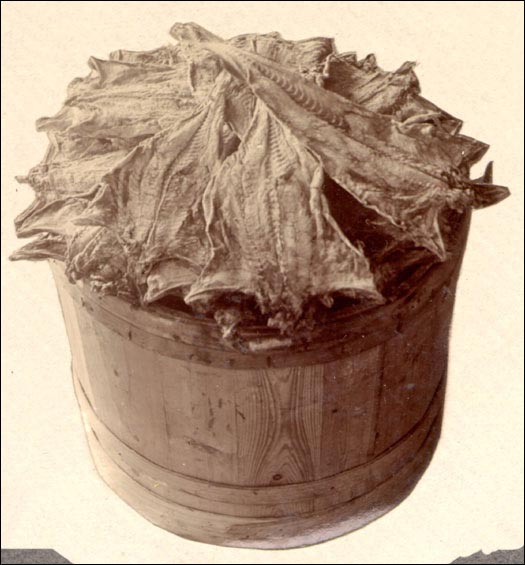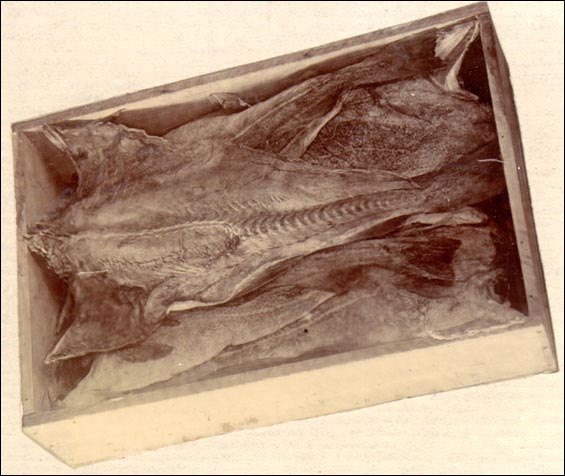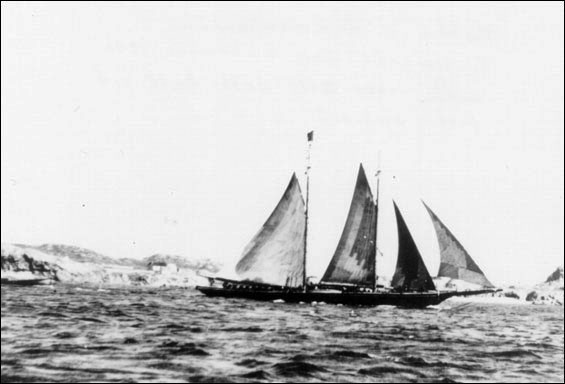19th Century Salt Fish Markets, 1850-1914
The first half of the nineteenth century saw changes in the markets for Newfoundland salt fish. The prosperity caused by the French Revolutionary and Napoleonic Wars (1793-1815) ended with the coming of peace. Newfoundland exporters recovered by finding new markets; for example, by compensating for the loss of Spain as a major market by gaining markets in Portugal, Italy, and the West Indies. Nevertheless, salt fish exports remained static or decreased slightly until the middle of the century. From the 1850s to 1914, exports of salt fish increased, but not enough to keep pace with the increase in population, and fishermen turned to new technology such as the cod trap to increase their catches. This masked a growing ecological problem. In addition, the quality and reputation of Newfoundland fish suffered, which in turn made it difficult to compete with countries such as Norway and France in European markets. By 1914 it was clear that the Newfoundland salt fish industry was in trouble.

1850 – 1900
The Spanish market for high-quality fish had recovered from its post-1815 decline by the 1840s. However, Spanish import tariffs remained high throughout the 1840s and 1850s, and the volume of imports fluctuated. In addition, there was serious competition from Norway which began after the Napoleonic Wars and increased substantially throughout the century. France later became an important player as its economy recovered after the wars, and its subsidized salt fish industry was re-established. By the 1870s, exports to Spain were in decline, and in the late 1890s averaged only about 35,000 quintals annually.
The Portuguese market remained important. Exports increased into the 1870s, peaking at about 308,000 quintals in 1874, and remained between 161,000 and 253,000 quintals until 1880. Exports to Portugal then began to decline, averaging 133,000 quintals in the 1890s. Competition from Norway and France, as well as minor competition from Portugal's own bank fishery compromised Newfoundland's market position. Nevertheless, Portugal remained important, purchasing a significant quantity of higher-quality Newfoundland fish.
Sales to the Italian market also declined over time, but by the 1870s and 1880s it was the single most important European purchaser of Newfoundland salt fish. It absorbed 300,000 quintals annually, about a quarter of the colony's total production. Much of this was Labrador-cured fish, which was smaller, moister and more heavily salted than shore-cured, and usually fetched a lower price. Moreover, Italian tariffs remained low. In the 1890s, Italian imports dropped dramatically to about 90,000-100,000 quintals annually. Again, competition from France and Norway undermined Newfoundland's position in this market.
The only European market where exports increased was Greece. This market developed slowly from the late 1850s to the 1880s. Its value was initially small, but imports rose to average almost 30,000 quintals in the 1890s. While this was a small amount, it did provide another outlet for Newfoundland exports, and would become even more important in the early years of the twentieth century. Like Italy, Grecian buyers also purchased Labrador-cured fish, although low demand kept the amount small.
Much more important were Brazilian and Caribbean markets. The British West Indies imported on average 123,000 quintals of salt fish from Newfoundland annually between 1860 and 1900, and the market in Brazil grew significantly to become one of Newfoundland's primary salt fish destinations. Exports averaged about 182,000 quintals in the 1860s, 277,000 in the 1870s, and 326,000 in the 1880s. Although Newfoundland enjoyed a near monopoly on the supply of salt fish to Brazil, from the 1850s it faced competition from other foodstuffs, notably jerked beef (beef cut into strips, salted, and dried). Brazil had a large cattle industry, whose primary products (besides meat) were leather, tallow, and bones. Turning surplus meat into jerked beef provided a cheap source of food. However, Newfoundland salt fish remained an important part of the diet. Low import tariffs, population increase (largely due to immigration from European countries, where salt fish was a staple) and consumer preferences all helped maintain the market position of Newfoundland salt fish. Imports remained at about 330,000 quintals annually into the 1890s, and grew even more in the early twentieth century. Importantly, both Brazil and the British West Indies bought large amounts of lower-quality fish, which allowed these markets to absorb product that could not be sold in the more demanding European markets.

1900 – 1914
The years leading up to the First World War saw more changes in Newfoundland's salt fish export economy. First, European markets, which had been in decline, recovered somewhat as French and Norwegian fisheries suffered temporary declines. Average annual exports to Spain rose to about 78,000 quintals in 1900-1904, 209,000 in 1905-1909, and 208,000 in 1910-1914. Portugal remained a primary market, imports at Oporto reaching about 207,000 quintals a year in 1905-1914. Italian markets as well recovered much of their lost ground, and by 1914 Italy was importing over 200,000 quintals a year. Combined with the relatively new Greek markets, which imported an average of about 53,000 quintals per year in 1905-1914, these markets consumed a large proportion of Newfoundland's salt fish. Despite competition from Norway, Portugal, and France, Newfoundland was exporting large amounts of salt fish to the southern European markets, which continued to be vitally important to Newfoundland's economy.
This did not mean that trade with Brazil and the Caribbean faded. Brazil purchased very large quantities of Newfoundland salt fish in the years before the First World War, about 335,000 quintals annually in 1901-1905, increasing to 418,000 quintals annually in 1911-1914. This represented between 26 and 32 percent of Newfoundland's total production. Exports to the British West Indies averaged another 175,000 quintals annually.

Competition
As indicated above, Newfoundland salt fish faced serious competition after 1815 from Norway and France. Norwegian fish could reach European markets more quickly than Newfoundland fish, and the coast of Norway enjoyed a longer ice-free season, which allowed a longer fishing season. More importantly, Norwegian fish was cured by the merchants, not by the fishermen, and exported from three depots only. This centralization ensured higher, more consistent quality and better transportation to market. These factors allowed Norway to make inroads into those European markets which demanded high-quality fish.
French outfitters re-entered the northwest Atlantic fishery after 1815, encouraged by their government, which provided various bounties on vessels and fish. Subsidization allowed the French to undersell Newfoundland fish in European markets, while high tariffs gave French producers a virtual monopoly in their domestic market. Although the French fishery at Newfoundland was in general decline throughout the period 1850-1914, the bank fishery based at St. Pierre remained an important competitor in European markets.
Summary
Between the 1850s and 1914, the Newfoundland fishery came to depend less on the markets of southern Europe, and much more on those of the Caribbean and Brazil. While European consumers still purchased large quantities of Newfoundland salt fish, especially the higher quality and more profitable fish, by the turn of the twentieth century most of Newfoundland's primary product was going south. These markets purchased the lower quality fish, and this trend indicates that the overall quality of Newfoundland salt fish had declined. The practice of buying 'tal qual' (meaning without culling, and paying the same price for fish no matter what the quality) reduced the incentive for fishermen to produce a superior product so that the quality, and therefore the price of Newfoundland salt fish had suffered by 1914. This severely hindered Newfoundland's ability to compete with fish-producing nations such as Norway and France, whose fisheries were organized so as to entice fishermen and merchants to produce better product.
Despite changes in fishing techniques which allowed for greater catches, most notably the cod trap, which came into use in the 1870s, the amount of fish exported each year increased only by about 40 percent over the century from 1815 (about 935,000 quintals) to 1914 (about 1,307,000 quintals). Yet Newfoundland's population increased by 400 percent, meaning that while the overall catch had increased, the catch per fisherman had actually declined. This relative decrease in catch shows that there was already significant pressure on cod stocks.
Newfoundland also suffered from the lack of a significant domestic market which could absorb product in times of slow sales. Some salt fish was consumed in Newfoundland, but the amount was small. Salt fish was the main, and often only source of income for the majority of the rural population, and it had to be exported to allow the purchase of necessary supplies. Competition from other protein food products also became a problem, notably Brazilian jerked beef and, after 1882, refrigerated meat from Australasia and South America.
At the start of the First World War, Newfoundland's economy was still dependent upon exports of salt fish. Despite attempts to industrialize and diversify the economy (see Industrialization and Diversification) the fishery was still the major employer and provided the major source of income for the island. Nonetheless, the decline in quality, reduction of European markets, and the drop in catches relative to population foreshadowed many of the problems that the fishery was to experience throughout the 20th century.




